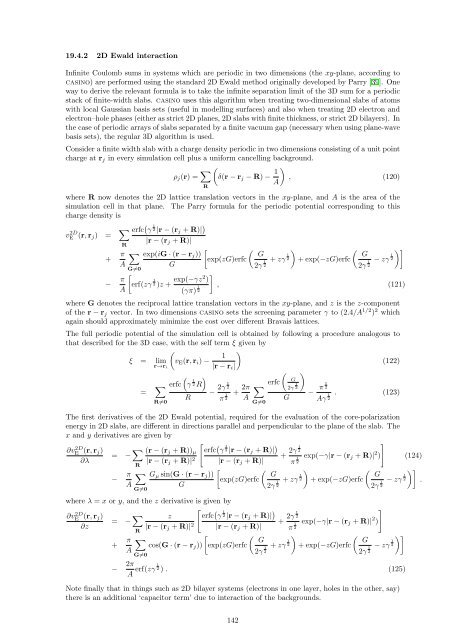CASINO manual - Theory of Condensed Matter
CASINO manual - Theory of Condensed Matter
CASINO manual - Theory of Condensed Matter
You also want an ePaper? Increase the reach of your titles
YUMPU automatically turns print PDFs into web optimized ePapers that Google loves.
19.4.2 2D Ewald interaction<br />
Infinite Coulomb sums in systems which are periodic in two dimensions (the xy-plane, according to<br />
casino) are performed using the standard 2D Ewald method originally developed by Parry [39]. One<br />
way to derive the relevant formula is to take the infinite separation limit <strong>of</strong> the 3D sum for a periodic<br />
stack <strong>of</strong> finite-width slabs. casino uses this algorithm when treating two-dimensional slabs <strong>of</strong> atoms<br />
with local Gaussian basis sets (useful in modelling surfaces) and also when treating 2D electron and<br />
electron–hole phases (either as strict 2D planes, 2D slabs with finite thickness, or strict 2D bilayers). In<br />
the case <strong>of</strong> periodic arrays <strong>of</strong> slabs separated by a finite vacuum gap (necessary when using plane-wave<br />
basis sets), the regular 3D algorithm is used.<br />
Consider a finite width slab with a charge density periodic in two dimensions consisting <strong>of</strong> a unit point<br />
charge at r j in every simulation cell plus a uniform cancelling background.<br />
ρ j (r) = ∑ (<br />
δ(r − r j − R) − 1 )<br />
, (120)<br />
A<br />
R<br />
where R now denotes the 2D lattice translation vectors in the xy-plane, and A is the area <strong>of</strong> the<br />
simulation cell in that plane. The Parry formula for the periodic potential corresponding to this<br />
charge density is<br />
vE 2D (r, r j ) = ∑ erfc ( γ 1 2 |r − (r j + R)| )<br />
|r − (r j + R)|<br />
R<br />
+ π A<br />
−<br />
π A<br />
∑<br />
G≠0<br />
exp(iG · (r − r j ))<br />
G<br />
[<br />
erf(zγ 1 2 )z +<br />
exp(−γz 2 )<br />
(γπ) 1 2<br />
[<br />
( G<br />
exp(zG)erfc<br />
2γ 1 2<br />
+ zγ 1 2<br />
)<br />
( G<br />
+ exp(−zG)erfc<br />
2γ 1 2<br />
− zγ 1 2<br />
]<br />
, (121)<br />
where G denotes the reciprocal lattice translation vectors in the xy-plane, and z is the z-component<br />
<strong>of</strong> the r − r j vector. In two dimensions casino sets the screening parameter γ to (2.4/A 1/2 ) 2 which<br />
again should approximately minimize the cost over different Bravais lattices.<br />
The full periodic potential <strong>of</strong> the simulation cell is obtained by following a procedure analogous to<br />
that described for the 3D case, with the self term ξ given by<br />
(<br />
)<br />
1<br />
ξ = lim v E (r, r i ) −<br />
(122)<br />
r→ri |r − r i |<br />
( )<br />
( )<br />
erfc γ 1 G<br />
2 R<br />
∑ erfc<br />
= ∑ R≠0<br />
R<br />
− 2γ 1 2<br />
π 1 2<br />
+ 2π A<br />
G≠0<br />
G<br />
2γ 1 2<br />
− π 1 2<br />
Aγ 1 2<br />
)]<br />
. (123)<br />
The first derivatives <strong>of</strong> the 2D Ewald potential, required for the evaluation <strong>of</strong> the core-polarization<br />
energy in 2D slabs, are different in directions parallel and perpendicular to the plane <strong>of</strong> the slab. The<br />
x and y derivatives are given by<br />
∂v 2D<br />
E (r, r j)<br />
∂λ<br />
= − ∑ [ ( 1<br />
(r − (r j + R)) µ erfc γ 2 |r − (r j + R)| )<br />
]<br />
|r − (r j + R)| 2 + 2γ 1 2<br />
exp(−γ|r − (r<br />
|r − (r j + R)| π 1 j + R)| 2 ) (124)<br />
2<br />
R<br />
−<br />
π ∑<br />
[<br />
( )<br />
( )]<br />
G µ sin(G · (r − r j ))<br />
G<br />
exp(zG)erfc + zγ 1 G<br />
A<br />
G<br />
2γ 1 2 + exp(−zG)erfc − zγ 1<br />
2<br />
2γ 1 2 .<br />
2<br />
G≠0<br />
where λ = x or y, and the z derivative is given by<br />
∂vE 2D(r,<br />
r j)<br />
= − ∑ [ ( 1<br />
z erfc γ 2 |r − (r j + R)| )<br />
]<br />
∂z<br />
|r − (r j + R)| 2 + 2γ 1 2<br />
exp(−γ|r − (r<br />
|r − (r j + R)| π 1 j + R)| 2 )<br />
2<br />
R<br />
+ π ∑<br />
[<br />
( )<br />
( )]<br />
G<br />
cos(G · (r − r j )) exp(zG)erfc + zγ 1 G<br />
2 + exp(−zG)erfc − zγ 1 2<br />
A<br />
G≠0<br />
2γ 1 2<br />
− 2π A erf(zγ 1 2 ) . (125)<br />
Note finally that in things such as 2D bilayer systems (electrons in one layer, holes in the other, say)<br />
there is an additional ‘capacitor term’ due to interaction <strong>of</strong> the backgrounds.<br />
2γ 1 2<br />
142

















